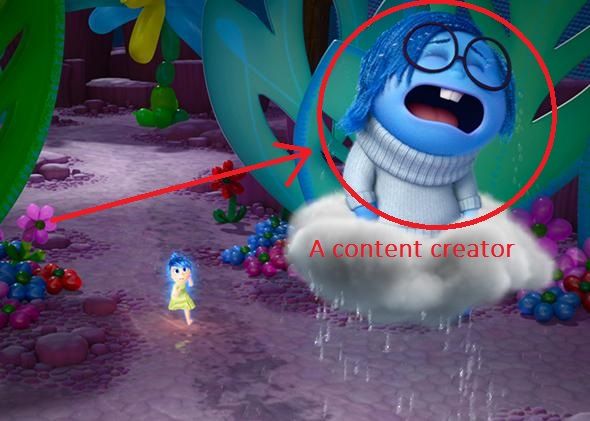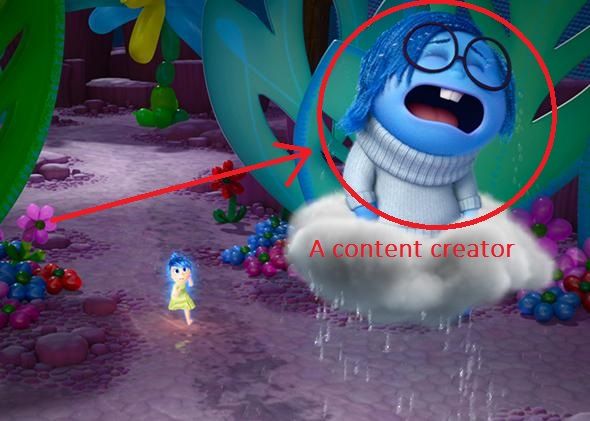
Inside Out: Why Sadness Is The Key to Happy Shareable Content
Are you a content marketer but you haven’t watched Inside Out yet?
Shame on you.
It’s all about five core emotions – Joy, Sadness, Anger, Fear, and Disgust – and their attempts to control the mind of an 11-year-old girl. And if you think it has nothing to do with content marketing in general and content creation in particular, I have a bad news for you:
You are mistaken.

The process of content creation is emotional. Those small “creatures” in your head help you come up with writing ideas and ways to turn those ideas into a part of your content marketing strategy. It’s not about writer’s block; it’s about emotions.
This is crazy:
The adventure into the depths of human mind lets us learn a secret weapon every content creator uses to generate writings that rock. And this weapon is neither a number of published guest posts nor marketing strategies used to increase a conversion rate.
They all are tools. As for a driving force, emotions rule here. There will not be good content without emotions, and the most surprising fact here is the key emotion for content creation should be… sadness.
Why? Let’s figure it out.
Sadness Creates Empathy
Marketers often use sadness to influence customers, as it causes compassion, desire to help, donate, etc. We all know the examples of advertisements where sadness was a key emotion to make people act and do what marketers wanted from them.
Why does it happen so?
When we are sad our brain produces cortisol and oxytocin, hormones of stress and empathy: the more oxytocin we have in our system, the more we will trust and empathize. So, to make us donate to charity or buy something to help others, it’s enough for marketers to cause sadness in our heads.
What does it mean? As a content creator, you can influence your audience by writing “sad” texts and making people act after they’ve read them.
All very well but:
How does sadness help marketers create compelling content, and why is it key?
Sadness Enhances Other Emotions

But Sadness has helped me learn 5 lessons for every content creator to remember:
- no one needs your 500-word articles;
- there is a big difference between content and compelling content;
- wordiness annoys;
- the skyscraper technique works;
- guest blogging should be something bigger than banal link building.
And it was Sadness who made me struggle for my content and not to sit and cry over the spilled milk aka rejected content ideas, pitches, and articles. She was (and is) a stimulus to improve writing skills and create better content to embrace more audience.
How does it work?
The trick is, sadness is key to enhancing other emotions: it causes fear, fear causes anger (sometimes, it comes together with disgust), anger galvanizes content creators into action. They start thinking about creating better headlines, adding essential writing elements to increase clicks, using different tricks to hook readers, learning from content marketing experts, and generating data-driven posts.
Fear
When a content creator is obsessed with sadness, his secret fear exposes – the fear of failure. That cool blog hasn’t approved your post for publishing, has it? And you start doubting whether your writings are good enough, whether they are worth sharing with readers, whether you should try pitching them to other publications, etc. You start comparing yourself with others, and you start fearing a failure.
Neil Patel:

Anger/Disgust
Oh, that feeling when your cool topics and data-driven content are rejected while some balderdash like “Top 10 Writing Tools” is continuing to come through top blogs again and again. (Just don’t tell me top bloggers and their audience still don’t know all those Evernote, Hemingway, Dropbox, ZenPen, and others of that ilk!)
First, you feel sadness (“Oh my… No… Again…”), and then anger comes (“How could they publish that mediocre content when I pitched them something really worth sharing?”)
Anger usually works in close connection with disgust, and this feeling of pissing off acts like a strong call to action: you start working on high-quality content that educates and entertains readers, you start writing for people, online reputation, and networking. As a content creator, you can use anger for self-development, professional growth, writing improvement, and finding alternative ways of sharing your content with people.
And what about Joy?
This emotion completes the circle: after your brain has got through all circles of hell, joy comes to prove you are good, you do your job well, and you should do your best to become a pro writer and generate the content both people and search engines will like.
It’s okay to be sad. Thanks to sadness, other core emotions work together, inspiring and motivating us to act, write, create, achieve, and go on.
The sky is the limit, as they say.
And how do your emotions help you deal with content creation and distribution?







I started reading this not hopping much but I found more than I expected. Simple and powerfull ideas here. Thanks. I hope I manage to follow some of these 🙂